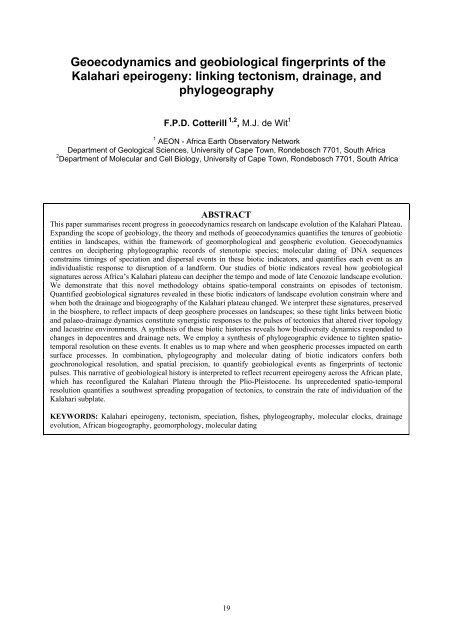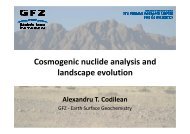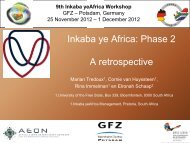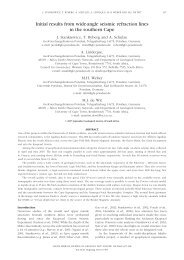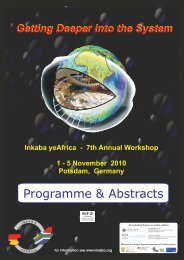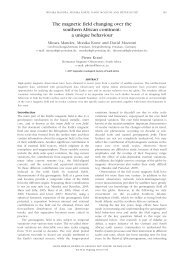South Africa - Inkaba.org
South Africa - Inkaba.org
South Africa - Inkaba.org
Create successful ePaper yourself
Turn your PDF publications into a flip-book with our unique Google optimized e-Paper software.
Geoecodynamics and geobiological fingerprints of the<br />
Kalahari epeirogeny: linking tectonism, drainage, and<br />
phylogeography<br />
F.P.D. Cotterill 1,2 , M.J. de Wit 1<br />
1 AEON - <strong>Africa</strong> Earth Observatory Network<br />
Department of Geological Sciences, University of Cape Town, Rondebosch 7701, <strong>South</strong> <strong>Africa</strong><br />
2 Department of Molecular and Cell Biology, University of Cape Town, Rondebosch 7701, <strong>South</strong> <strong>Africa</strong><br />
ABSTRACT<br />
This paper summarises recent progress in geoecodynamics research on landscape evolution of the Kalahari Plateau.<br />
Expanding the scope of geobiology, the theory and methods of geoecodynamics quantifies the tenures of geobiotic<br />
entities in landscapes, within the framework of geomorphological and geospheric evolution. Geoecodynamics<br />
centres on deciphering phylogeographic records of stenotopic species; molecular dating of DNA sequences<br />
constrains timings of speciation and dispersal events in these biotic indicators, and quantifies each event as an<br />
individualistic response to disruption of a landform. Our studies of biotic indicators reveal how geobiological<br />
signatures across <strong>Africa</strong>’s Kalahari plateau can decipher the tempo and mode of late Cenozoic landscape evolution.<br />
We demonstrate that this novel methodology obtains spatio-temporal constraints on episodes of tectonism.<br />
Quantified geobiological signatures revealed in these biotic indicators of landscape evolution constrain where and<br />
when both the drainage and biogeography of the Kalahari plateau changed. We interpret these signatures, preserved<br />
in the biosphere, to reflect impacts of deep geosphere processes on landscapes; so these tight links between biotic<br />
and palaeo-drainage dynamics constitute synergistic responses to the pulses of tectonics that altered river topology<br />
and lacustrine environments. A synthesis of these biotic histories reveals how biodiversity dynamics responded to<br />
changes in depocentres and drainage nets. We employ a synthesis of phylogeographic evidence to tighten spatiotemporal<br />
resolution on these events. It enables us to map where and when geospheric processes impacted on earth<br />
surface processes. In combination, phylogeography and molecular dating of biotic indicators confers both<br />
geochronological resolution, and spatial precision, to quantify geobiological events as fingerprints of tectonic<br />
pulses. This narrative of geobiological history is interpreted to reflect recurrent epeirogeny across the <strong>Africa</strong>n plate,<br />
which has reconfigured the Kalahari Plateau through the Plio-Pleistocene. Its unprecedented spatio-temporal<br />
resolution quantifies a southwest spreading propagation of tectonics, to constrain the rate of individuation of the<br />
Kalahari subplate.<br />
KEYWORDS: Kalahari epeirogeny, tectonism, speciation, fishes, phylogeography, molecular clocks, drainage<br />
evolution, <strong>Africa</strong>n biogeography, geomorphology, molecular dating<br />
19


